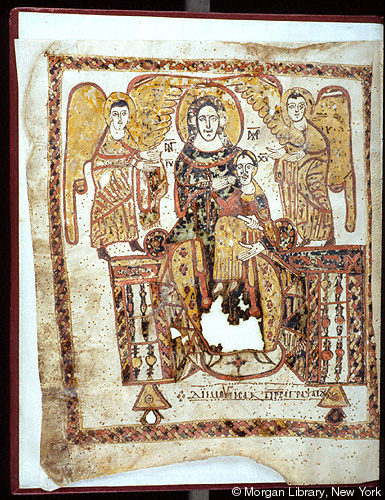
Manuscript of the Encomium on the four bodiless beasts, attributed to John Chrysostom; written and illuminated at Ptepouhar, Fayyūm Province, Egypt, between Aug. 29, 892 and Aug. 28, 893.
Title: "An ecomium which Apa John Chrysostom archbishop of Constantinople delivered on the glorious Four Bodiless Beasts, which some zealous and honorable people begged him, 'Give us to drink from the spring of your blessing.' The archbishop, then, rejoiced in the Holy Spirit and delivered this encomium to the glory of the holy Bodiless (Beasts) on the 8th day of the month of Hātōr. In God's peace. Amen." Edited and translated into English by Wansink in Depuydt, 1991.
Colophon: 1) fol. 1v: Artist-copyist in Greek: Eïsak (identical with Isak in 4) below);2) Donation in Coptic: By the monk Brother Papostolos, son of Deacon Iōhannēs; to the Monastery of St. Michael near present day Hamuli; 3) Memorial in Coptic: For the archimandrite Deacon Io(̄hannēs); the fathers Papa Theōdoros, Papa Khaēl, Deacon Makari, Deacon Stephen; and the brothers Mēna, Hulia, and Kabri (the last in rasura); 4) Copyist, place and date of copying in Coptic: By Papa Isak the [writer] residing in Ptepouhar; AM 609.--Ed. van Lantschoot.
Isak also copied a column or so on fol. 35v of M.567.--Cf. Drescher, vol. 1, xii.
Written area ca. 256 x 185 mm. Divisions: Ekthesis, reddened enlarged or greatly enlarged initial, and paragraphus sign (Touton style with budded diple in column a and reddened obelus in column b) setting off paragraphs.
Script: Upright (titles and colophons right-sloping). 10 lines = ca. 84 mm
Superlineation: Non-standard. Punctuation: Raised reddened dot in conjunction with a space; cluster of dots followed by a space filler at ends of paragrahs. Tremas.
Collation: Signed on first and last page of the quire, top inner margin. No quire ornaments, monograms, headlines or catchwords.
Decoration: frontispiece illumination, headpiece, marginal ornaments, major initials, paragraphus signs, signatures and page numbers, extended letters. Colors: strong reddish orange, dark orange yellow, green (chemically altered).
Scribe: Papa Isak, residing in Ptepouhar.
Artist: Papa Isak, residing in Ptepouhar.
A related fragment that completes the text block of Pierpont Morgan Library MS M.612 is found in Berlin, Germany, in the former Berlin State Museum, Papyrus-Sammlung (Ägyptisches Museum und Papyrussammlung, P. 11965). According to Hyvernat and Petersen, the present manuscript and M.611 together formed one codex, whose pastedowns and covers, according to Petersen, are Ms 3822 (Cairo Ham. I, formerly JdE 47558) and Binding 3828 respectively, both now at Cairo. Depuydt notes that perhaps the present manuscript and M.611 were originally separate codices later bound together in the same ancient binding (Binding 3828 in Cairo).--Cf. Depuydt 1993, no. 96, Hyvernat, p. 1935, n. 4, and Petersen, p. 316, n. 13.
